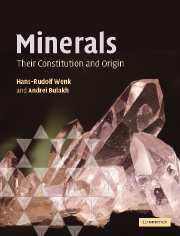Book contents
- Frontmatter
- Contents
- Preface
- Acknowledgments
- Figure credits
- Part I Structural features of minerals
- 1 Subject and history of mineralogy
- 2 Elements, bonding, simple structures, and ionic radii
- 3 The concept of a lattice and description of crystal structures
- 4 Macroscopic symmetries : crystal morphology
- 5 Crystal growth and aggregation
- 6 Isomorphism, polymorphism, and crystalline defects
- Part II Physical investigation of minerals
- Part III Variety of minerals and mineral-forming processes
- Part IV A systematic look at mineral groups
- Part V Applied mineralogy
- Appendices
- Glossary
- References
- Index
- Plate section
- References
1 - Subject and history of mineralogy
from Part I - Structural features of minerals
- Frontmatter
- Contents
- Preface
- Acknowledgments
- Figure credits
- Part I Structural features of minerals
- 1 Subject and history of mineralogy
- 2 Elements, bonding, simple structures, and ionic radii
- 3 The concept of a lattice and description of crystal structures
- 4 Macroscopic symmetries : crystal morphology
- 5 Crystal growth and aggregation
- 6 Isomorphism, polymorphism, and crystalline defects
- Part II Physical investigation of minerals
- Part III Variety of minerals and mineral-forming processes
- Part IV A systematic look at mineral groups
- Part V Applied mineralogy
- Appendices
- Glossary
- References
- Index
- Plate section
- References
Summary
What is mineralogy?
The answer to the question posed above may seem obvious: mineralogy is the study of minerals. From introductory geology classes you may know that all rocks and ores consist of minerals. For instance, quartz, biotite, and feldspar are the main minerals of granites; and hematite and magnetite are the major minerals of iron ores. At one point mineralogy was well defined as dealing with those naturally occurring elementary building blocks of the earth that are chemically and structurally homogeneous. This simple definition of a mineral has changed over time. As the definition of “mineral” has become more vague, the boundaries of “mineralogy” have opened and increasingly overlap other sciences.
In this book we take a broad view of mineralogy. Minerals are naturally occurring, macroscopically homogeneous chemical compounds with a regular crystal structure. Also included are homogeneous compounds that do not have a regular structure such as opal (a colloidal solid), natural liquid mercury, and amorphous mineral products formed by radioactive decay. (Such products are known as metamict minerals.) Rocks, ores, and mineral deposits, which are studied in petrology and geochemistry, will also be discussed in order to emphasize the geological processes that are of central interest to all who study earth materials.
Other materials are more peripheral but nevertheless have similar properties and obey the same laws as the minerals mentioned above. For example ice, a mineral according to our definition, is mainly the object of glaciology and soils science.
- Type
- Chapter
- Information
- MineralsTheir Constitution and Origin, pp. 3 - 11Publisher: Cambridge University PressPrint publication year: 2004



